In my last week’s post, I illustrated
- why the concept of superfoods is a brain fart,
- why a super-combo of foods is a much better idea,
- and how to use the super-combo as a daily longevity vaccine.
My main gripe with superfoods is that none are “super” across the nutrient board. The solution is to combine several foods that, together, cover the entire spectrum of nutrients necessary to slow down or even reverse biological aging.
Blend them into a power smoothie that replaces one daily meal (possibly breakfast), and you’ll get far more rejuvenation bang than from any diet or supplement.
But then there is the big question: How do we know whether such a rejuvenating super-combo really does what it promises? That is, keeping you biologically younger.
The Evidence
Researchers from the U.S. Institute of Functional Medicine and from the American Nutrition Association set out to answer that question [1].
They designed a super-combo diet to decelerate aging. Six healthy women enrolled in an 8-week study during which they had to arrange their daily meals around the prescribed super-combo (it wasn’t delivered as a smoothie).
The researchers observed the diet’s effect on the participants’ biological aging clocks. And, lo and behold, five of those women had their biological age reduced by almost five years. The sixth woman didn’t see any change.
The media (Fortune) dutifully peddled these results to their lay readers.

I don’t know about you, but to me, such articles aren’t worth anything if the readers can’t apply this information to themselves.
I’ll give you three reasons why that is the case.
Once you understand them, you will be happy to hear how, with a little tweak, you can probably achieve and observe even better results than those six women.
The Problem With The Evidence
The reasons to be skeptical:
- Translational: What does it mean to score younger on that particular clock?
- Statistical: How trustworthy is the “5-year” rejuvenation?
- Practical: Can you replicate the intervention?
Translational:
The BioAge clock that the researchers used was the first to hit the research scene.
Steve Horvath and colleagues developed it in 2011 [2]. They had discovered that the expression of genes changes rather predictably with age.
Gene expression is the process by which the information stored in a gene is used to make a protein or other molecule that performs a specific function.
While some genes are being expressed more readily as you grow older, others are being suppressed.
The molecule that drives gene expression—methyl—does its job very much like the hotel door tag that says on one side “Do Not Disturb” and “Make Up Room” on the other.
So, when Horvath looked at the overall methylation of DNA, he discovered that a 60-year-old who has the vitality and health of an average 40-year-old will have a different methylation pattern than a 60-year-old who resembles less-functional 70-year-olds.
That’s how these patterns give us a read-out on biological age.
Now here is the sticking point: We don’t know whether modifying the methylation patterns will affect life and health expectancy. Or whether the patterns are simply a gauge, much like your room thermometer. You can’t change your room temperature by pushing the thermometer needle.
What we do know is that different BioAge clocks measure different things, come to different age estimates, and correlate only very weakly with health outcomes [3].
We also know that attempts to modify the epigenetic clocks (like Horvath’s clock) produce conflicting results [4].
So, how does the 5-year rejuvenation translate into tangible health and survival benefits?

Nobody knows.
Statistical
We simply cannot draw any conclusions from this study for so many reasons.
To be fair to the study authors, they warned us about that upfront in the title: they called it a case series, which is the lowest grade of evidence, if you can call it evidence at all.
- Lack of a control group
- Unknown variance
- Insufficient duration
First, there is no control group to compare the results with. That is, a group of women who did NOT follow the diet and who had their BioAge measured before and after the 8-week trial period.
Second, we do not know the variability (or variance) of the BioAge measurement. That is, what is the spread of results when you have your BioAge measured today, tomorrow, and the day after tomorrow? In biology, there is no biomarker that delivers the exact same result on repeat measurements. The wider the spread, the more difficult it is to separate true effects from measurement noise.
Upon digging a little deeper, I found that the same research group had conducted a more stringent experiment on men 2 years earlier [5]. That experiment had a control group and more than 40 participants.
The results were quite discouraging: on average, there was a less than 2-year reduction in biological age, which was not significant. The control group also increased their biological age by almost 2 years, which tells us a lot about the variance (over a span of 8 weeks, you wouldn’t expect a 2-year change).
Third, the duration is way too short to draw any conclusions about the long-term effects. Sustaining that diet for 8 weeks is already challenging. But for the rest of your life?
So, what happens once you discontinue the diet? Will the reductions in BioAge peter out?
Probably.
And even if you sustain the diet, will the BioAge benefits hold? I have seen it happen so often in research: very encouraging short-term results that fizzle out in the longer run.
Which brings me to the third point:
Practicality
Aside from the adherence issue, there is the practical issue of measuring DNA methylation. You need to draw a saliva sample, deep freeze it, send it to a qualified lab, and pay quite some money to get the analysis done. That goes for all BioAge clocks. Which puts them past the outer orbit of practicality as a self-experiment.
Most importantly, what is the point of following a less-than-pleasant diet if you can’t check whether it delivers the desired results?
The Solution
It solves the three issues I mentioned earlier:
- Translational: A BioAge clock that translates into future health outcomes
- Statistical: a method to make that translation reliable
- Practical: a tool that makes points 1 and 2 accessible to every lay-person
Aging is defined as a progressive decline in physiological function. Almost all researchers agree on that core definition. The one function that has emerged as a key to determining a person’s functional (aka biological) age is cardiovascular function.
More precisely, the function of one’s vasculature (specifically the arteries).
That’s why the term early vascular aging (EVA) has emerged as a label for aging faster than one should [6].
The research interest in EVA has grown exponentially over the past 15 years (see chart below).
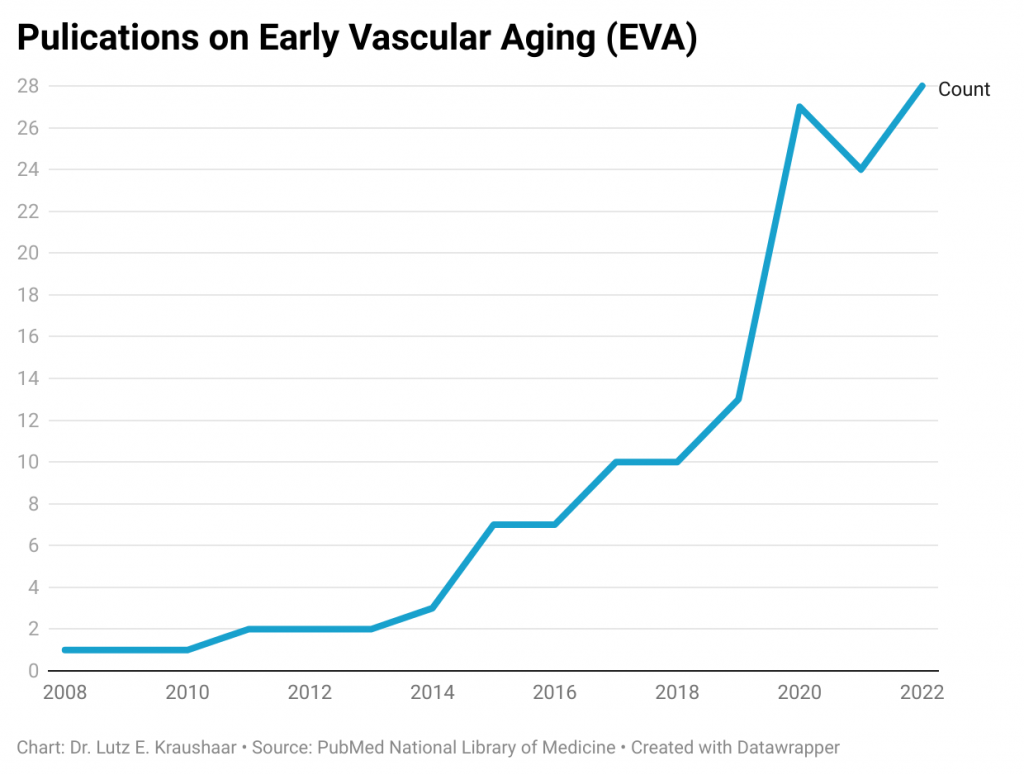
Since there is EVA, there is a term for those who age slower than what is the norm: supernormal vascular aging, or SUPERNOVA.
What is my point?
Translation
Since we can measure vascular function easily, my colleagues and I developed a BioAge clock that is based on the one metric that best describes it: pulse wave velocity (PWV).
I have explained PWV in another post, but here it is in brief:
PWV is a measure of how fast the blood pressure wave travels along the arterial tree.
The stiffer the vessels, the higher the PWV, the “older” the person.
We took several hundred volunteers, covering the entire health and age spectrum, and found a formula that translates PWV not only into vascular age but into the pace of aging. One formula for women and one for men.
Since it has become easy, even for laypeople, to measure PWV daily, you can generate lots of data. To evaluate those data, you need…
Statistics
You have probably heard that medical science relies heavily on so-called randomized clinical trials. They use large groups of people to detect the effects of interventions.
But what if you have only one person? You yourself?
There is a gold standard method for those situations. It is called N-of-1 (“N” being the number of participants in an experiment or trial).
I have described N-of-1 in another post.
We are the first to operationalize this method. Specifically for laypeople’s self-experimentation with lifestyle measures.
As an aside, two German Federal Ministries found our idea worth funding.
The graph below illustrates how N-of-1 works (just ignore the doctor character, whom you won’t need in our case).
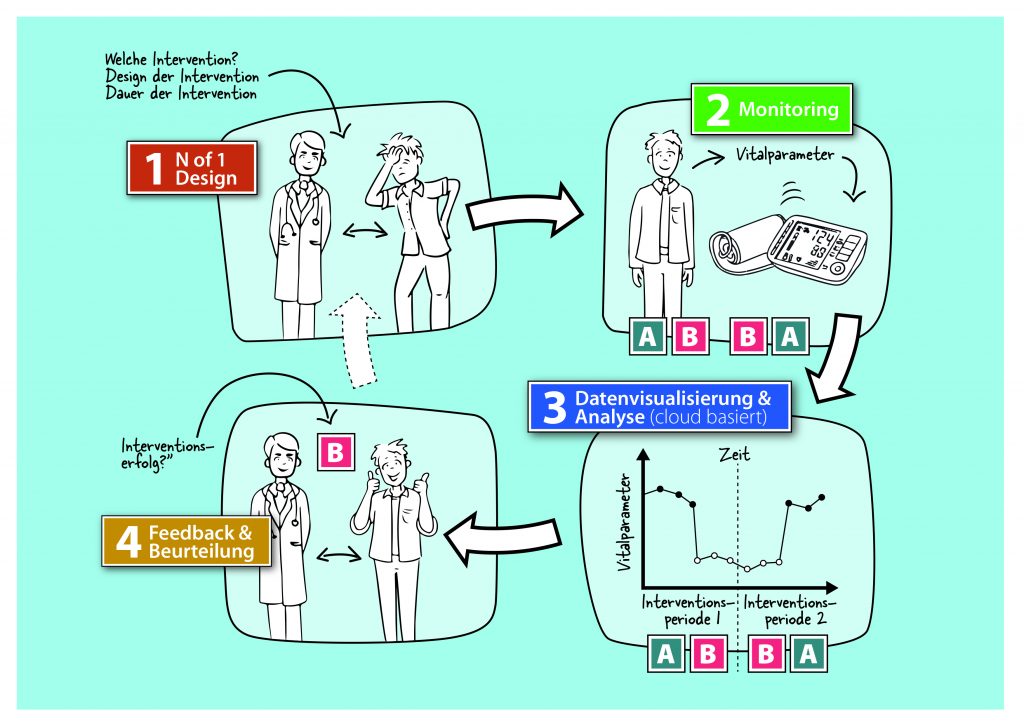
Individualised Lifestyle Medicine using N-of-1 methodology
Briefly, in a N-of-1 experiment, you measure your PWV (or any other biomarker) daily over at least two periods, during which you alternate your “intervention” with “no intervention”.
It doesn’t matter whether that intervention is the super-combo, a supplement, or an exercise routine.
What you want to know is whether it has an effect on your vascular age and how large this effect is.
Since doing maths and statistics holds as much appeal to most people as a root canal treatment, we had to look at…
Practicality
We had to solve two issues:
- First, measurement of PWV
- Second, make the headache of statistics disappear.
PWV measurement.
The one company that produces an ingenious and affordable device for laypeople to measure their PWV is Withings.
I am not saying this because I get commissions from Withings (which I don’t). They are simply the only company with a scale that performs a PWV measurement whenever you step on it.
BTW, independent researchers validated this scale [7]. Which is why we are using it.
Solving the statistics issue
We simply automated the statistical evaluation on a platform that we called LiLo, an abbreviation for the German “Lifestyle Lotse”, which translates into lifestyle pilot.
The scale communicates its measurement data via WLAN to a central server.
LiLo picks it up from there, grinds the data through the N-of-1 statistics, and gives you easy-to-understand feedback on how your super-combo (or any other lifestyle measure) affects your rate of vascular aging.
In Summary
The whole process of PWV measurement, data transmission, statistical evaluation, and visualization, all of it condensed into stepping on a bathroom scale and opening your digital profile.
How To Use The Solution For Yourself
In case you are interested, the scale sets you back between 150 and 190 dollars or euros.
Here are two links to the relevant Amazon sites (one in Germany, the other in the US).
Both are affiliated links; that is, if you purchase the scale by following these links, I will receive a small commission at no cost to you.
If you want to connect your scale to our platform, you’ll need to contact me (see below).
We have developed LiLo as an “all-function, no-frills” MVP that we have used until now predominantly for research purposes.
But we are ready to accept lay users.
So, if you are keen on piloting your lifestyle measures dead-on-target towards a biologically younger self, LiLo may be your best bet.
Real-life examples
Of course, I am biased. But below you see three charts, including mine and my wife’s, showing how we do in our “piloting” efforts. We age at a rate below 1 year per year. That is, for every 12 calendar months, we age by only 10 or so.
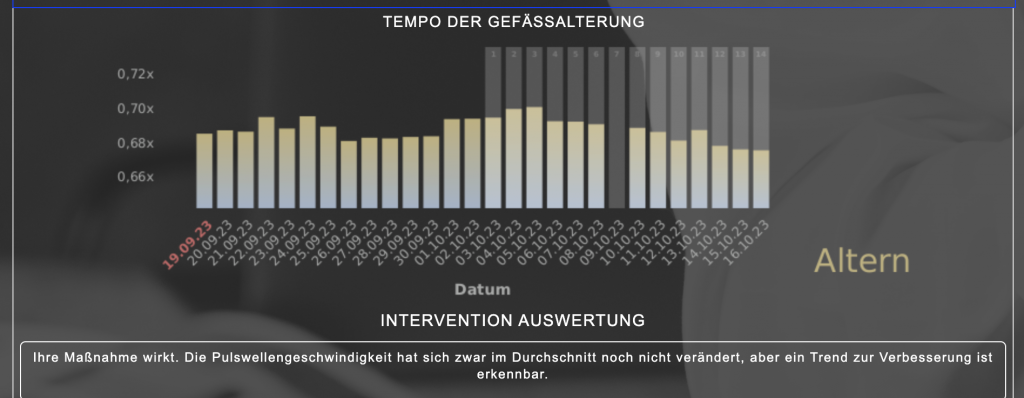
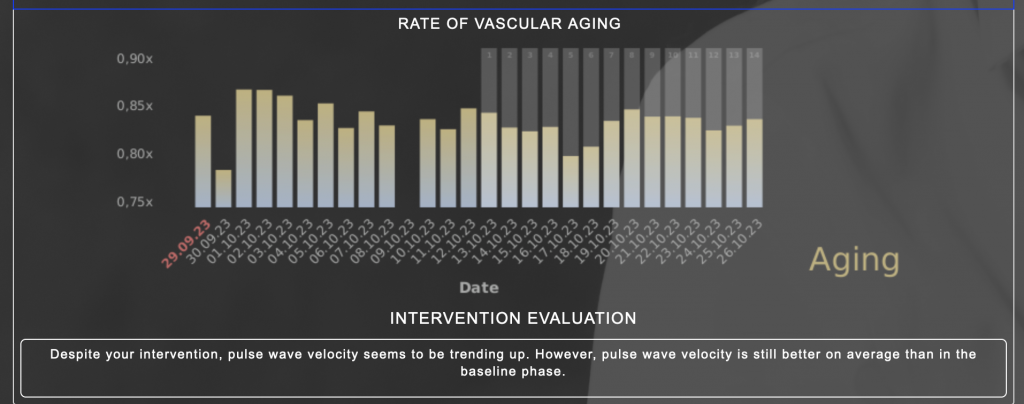
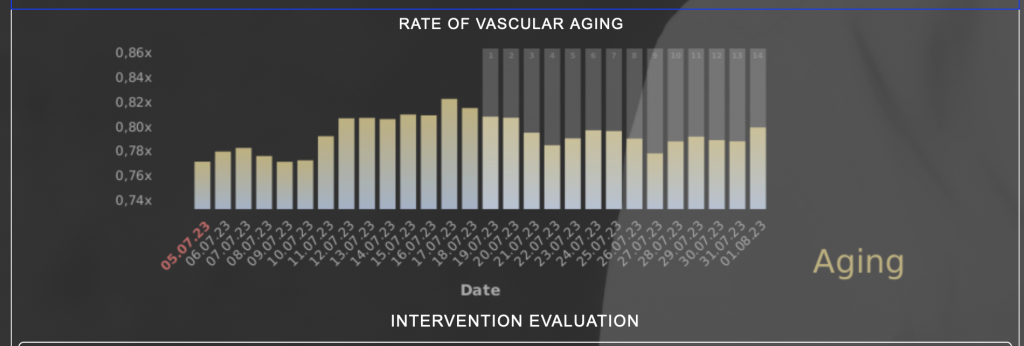
And believe me, it’s worth the effort. Both of us are on the wrong side of 60 (by calendar age), but we have no cardiovascular disease, no cancer, and no diabetes. We take no medication, and we are fitter than most people who are 20 years younger.
That’s probably due not only to our daily super-combo smoothie, but that’s not the point. Without knowing exactly where you go with whatever lifestyle measures you take, how can you be sure to end up in the place where we are now?
References
[1] Fitzgerald KN, Campbell T, Makarem S, Hodges R. Potential reversal of biological age in women following an 8-week methylation-supportive diet and lifestyle program: a case series. Aging (Albany NY) 2023;15:1833–9. doi:10.18632/aging.204602.
[2] Bocklandt S, Lin W, Sehl ME, Sánchez FJ, Sinsheimer JS, Horvath S, et al. Epigenetic Predictor of Age. PLoS One 2011;6:e14821.
[3] Belsky DW, Moffitt TE, Cohen AA, Corcoran DL, Levine ME, Prinz JA, et al. Eleven Telomere, Epigenetic Clock, and Biomarker-Composite Quantifications of Biological Aging: Do They Measure the Same Thing? Am J Epidemiol 2017;187:1220–30. doi:10.1093/aje/kwx346.
[4] Mahmoud AM, Ali MM. Methyl donor micronutrients that modify DNA methylation and cancer outcome. Nutrients 2019;11:1–30. doi:10.3390/nu11030608.
[5] Fitzgerald KN, Hodges R, Hanes D, Stack E, Cheishvili D, Szyf M, et al. Potential reversal of epigenetic age using a diet and lifestyle intervention: a pilot randomized clinical trial 2021;13:9419–32.
[6] Bruno RM, Nilsson P, Engsrtöm G, Wadström B, Empana J-P, Boutouyrie P, et al. Difference Between Chronological And Vascular Age As A Predictor For Cardiovascular Events – Identification Of Patients With Supernormal Vascular Aging (Supernova). J Hypertens 2021;39.
[7] Collier SR, McCraw C, Campany M, Lubkeman A, Stclair P, Ji H, et al. Withings body cardio versus gold standards of pulse-wave velocity and body composition. J Pers Med 2020;10. doi:10.3390/jpm10010017.

